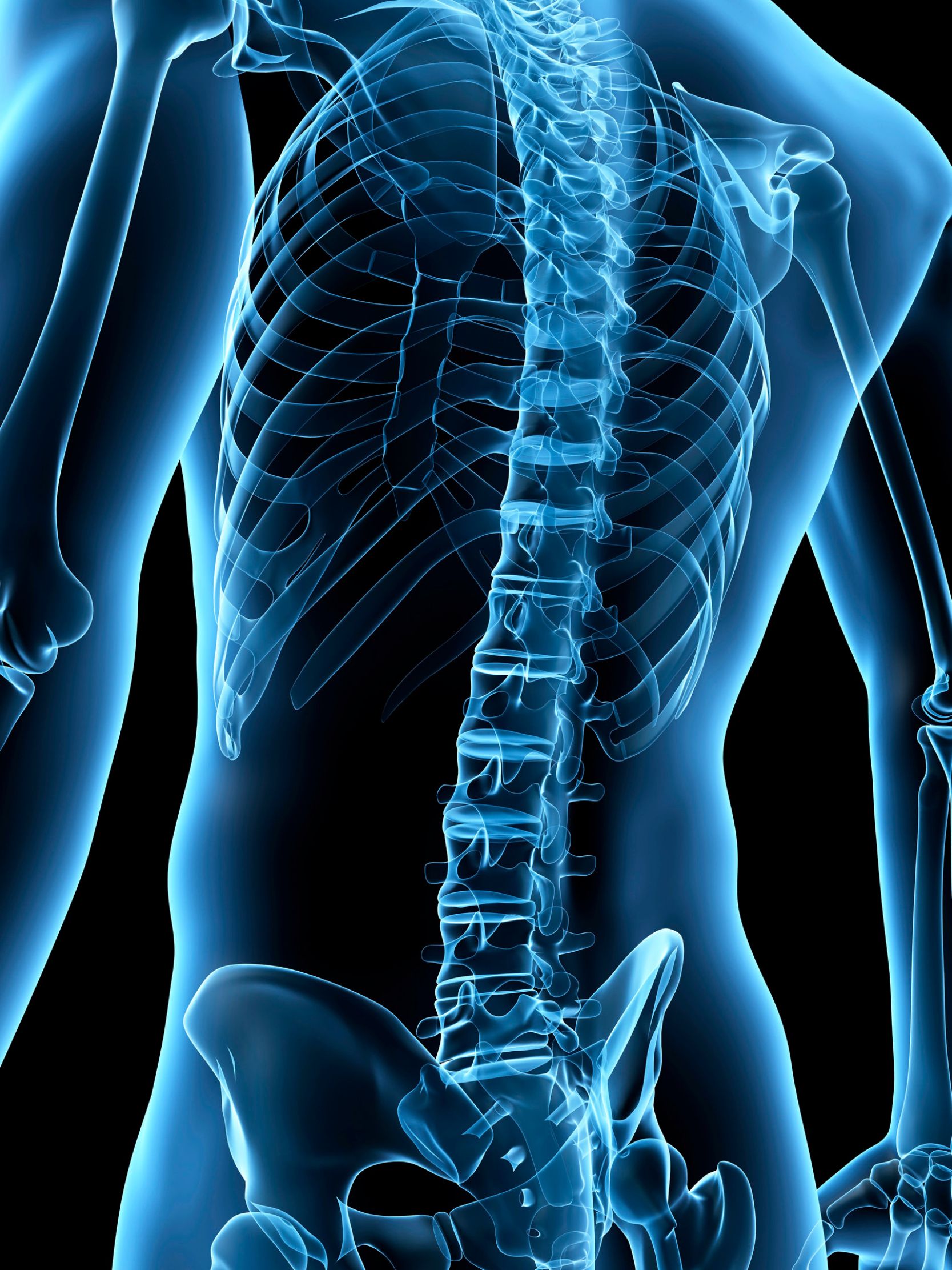
Osteoporosis
Osteoporosis does not directly cause back pain. It's a condition that arises from substantial bone mass loss, leading to what are known as fragility fractures. These occur when a fall from standing height or less results in a broken bone. Fragility fractures can happen anywhere in the body but are typically found in the spine, hip, or wrist.
Signs of vertebral fractures may include:
- Back pain varying from mild to severe, potentially incapacitating
- Reduction in height
- Diminished spinal mobility and flexibility
- Stiffness in the spine
Stress Fracture
Spondylolysis refers to a defect or stress fracture in one of the vertebrae, the small bones constituting the spinal column. In certain instances, this stress fracture can weaken the bone to such an extent that it fails to sustain its correct position in the spine, causing the vertebra to shift or misalign. This condition is known as spondylolisthesis.
Both spondylolysis and spondylolisthesis are frequent sources of lower back pain in children and adolescents. Even without any identifiable injury, this condition or weakness can manifest in children as young as six years old. Adolescent athletes involved in sports that repeatedly strain the lower back, such as gymnastics, football, and weightlifting, can also experience such stress fractures.
Sciatica
Sciatica is a common type of pain affecting the sciatic nerve, a large nerve extending from the lower back down the back of each leg.
The telltale sign of sciatica is pain that starts in the lower back and shoots down one leg, sometimes all the way into the foot. It can happen with an injury or just with the wear and tear of ageing.
Stenosis
Spinal stenosis refers to the constriction of one or more areas within the spinal canal, a tunnel that houses the spinal cord and runs through every vertebra in the spine. The reduction in space inside the spinal canal can squeeze the spinal cord and its branching nerves (nerve roots).
When these nerve spaces become narrow, it can result in the irritation, compression or impingement of the spinal cord or nerves. This often manifests as back pain or other nerve-related problems such as sciatica. Various conditions and injuries can contribute to the narrowing of the spinal canal.
Pars Defect
Spondylolysis, Pars defect, and Stress fracture - these three labels all point to the same medical issue. Spondylolysis represents a stress fracture that occurs in the pars interarticularis of the lumbar vertebrae.
The pars interarticularis (pars) lies between the superior and inferior articular process bilaterally at each vertebral level and is the most susceptible area to repetitive stress damage. This is a relatively prevalent condition, affecting one in every 20 individuals.
Herniated Disc
A herniated disc, also referred to as a slipped, ruptured, or bulging disc, is a prevalent source of neck, back, and leg pain. A herniated disc is a spinal injury — the spine consists of a series of bones known as vertebrae, extending from the base of the skull to the tailbone. These vertebrae are cushioned by round buffers known as discs that facilitate bending and movement.
When one of these discs tears or leaks, it results in what is termed a herniated disc. Flexion and/or rotation movements can aggravate herniated disc-related pain. These discs can recover naturally to a state that doesn't cause pain but often require straightforward care procedures.
Facet Joint Pain
Located in the posterior section of the spine are the facet joints, present at every vertebral level, with one on either side of the spine. Facet arthritis can lead to discomfort and stiffness. The pain associated with this condition is usually localised in the spine close to the affected joint, but it can also manifest in other parts of the body.
For instance, cervical (neck) facet arthritis may cause pain that radiates towards the back of the head, ear, or shoulder. Similarly, lumbar (lower back) facet arthritis might result in pain extending towards the buttock, hip, or thigh. Certain movements like extension or long periods of inactivity or sleep often exacerbate the pain.
Degenerative Disc Disease
Degenerative Disc Disease (DDD) is a condition characterised by the weakening of one or more discs in the back. Despite its name, it isn't exactly a disease, but rather a progressive condition that develops over time due to wear and tear or injury.
The discs in the back are situated between the vertebrae of the spine, serving as cushions and shock absorbers. These discs play a crucial role in enabling standing upright and carrying out daily movements like twisting and bending. As time goes by, degenerative disc disease can progress, potentially leading to pain ranging from mild to severe, which can disrupt daily activities.
Osteoarthritis
Spinal osteoarthritis refers to the deterioration of the cartilage in joints and discs located in the neck and lower back. Occasionally, this condition can lead to the formation of spurs that exert pressure on the nerves exiting the spinal column, resulting in weakness and pain in the limbs.
Typically, osteoarthritis is associated with aging. However, there are several reasons why younger individuals may develop the condition, including a genetic defect related to cartilage, or damage or trauma to a joint.
In individuals under 45, osteoarthritis is more prevalent amongst men. However, post 45, the condition is more frequently observed in women. Overweight individuals are more likely to experience osteoarthritis, as are those engaged in occupations or sports that subject specific joints to repetitive stress.
Sacroiliac Joint Dysfunction
Also referred to as SI joint dysfunction, Sacroiliac joint dysfunction is a medical condition known for causing discomfort or pain in the lower back and/or legs. The sacroiliac joints are situated at the base of the back on either side of the spine, where the sacrum (the spine's lowest part) connects with the iliac bones (components of the pelvis).
The role of the SI joints is to bear the weight of your upper body during standing or walking, transferring this weight to your legs. These joints also function as shock absorbers for the spine and contribute to the body's stability.
Disruption of the joint's normal movement, whether due to excessive (hypermobile) or insufficient (hypomobile) movement, can result in SI joint dysfunction. This condition can manifest through symptoms such as:
- Discomfort or pain in the lower back, hips, buttocks, or potentially the groin.
- Pain that could be sharp, dull, or stabbing, typically localized to one side of the lower back and may extend down the leg.
- Pain that can intensify with certain activities like standing, walking, or climbing stairs, but may alleviate when sitting or lying down.
Post Partum Back Pain
Postpartum back pain can be attributed to several factors, which include:
- Hormonal changes during pregnancy that result in the loosening of ligaments and joints.
- Overworked abdominal muscles used to support the “baby bump” and during childbirth (if labour was involved), potentially disrupting back alignment and overall posture.
- Constant bending, lifting, and rocking of baby, activities that become part of daily routines.
Incorrect handling of a growing baby can also subsequently contribute to postpartum back pain.
Spondylolisthesis
Spondylolisthesis is a spinal condition in which one of the vertebrae slips forward onto the bone directly beneath it. This can occur anywhere along the spine, but it's most common in the lower back (lumbar spine).
There are various types of spondylolistheses, and the causes vary depending on the type. Some people are born with a congenital defect or fracture that leads to spondylolisthesis, while others develop it due to excessive wear and tear on the spine from age or sports. Physical trauma or certain diseases and conditions can also cause spondylolisthesis.
Symptoms of spondylolisthesis include lower back pain, stiffness in the back and tightness of the hamstring muscles, pain and/or weakness in one or both thighs or legs, and difficulty controlling bladder or bowel movements in severe cases,
Avoidance of single leg activities in early phases of rehab is recommended.


